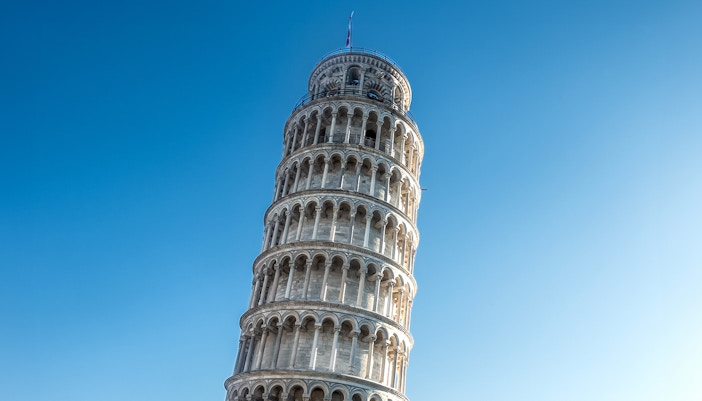Leaning Tower of Pisa History | Evolution & turning points
Why was the Leaning Tower of Pisa built?

The third structure of the city of Pisa's Square of Miracles, the Leaning Tower of Pisa was specifically designed to function as the facility's bell tower. The structure is situated some distance behind the Cathedral, but visitors can instantly spot due to its lean when they enter the Cathedral Complex.
Read more about the Leaning Tower of PisaDetailed history of the Leaning Tower of Pisa

Donna Berti di Bernardo makes a contribution
1172
Donna Berta di Bernardo, a widow and resident of the house of dell'Opera di Santa Maria, bequeathed sixty soldi (Italian silver coins) to the Opera Campanilis petrarum Sancte Marie (the organization that oversaw the tower's construction), which was used for building the tower.

Construction of the Tower begins
1173
The bell tower’s construction began in 1173 as the third part of the city's cathedral complex. Although it is not known who the original architect of the tower was, the project was started under the direction of architect Bonanno Pisano or Gerardo di Gerardo.

The tilt starts and construction halts
Late 1170s
Because of the soft ground beneath the building's foundations, the tower started to tilt soon after the beginning of the construction. By the time they built three of its eight floors, the tilt had worsened so much that they had to pull the brakes on building it to find a solution. Meanwhile, a war broke out between Pisa and the nearby city-state, Genova, and construction was halted for about 100 years.

Construction resumes
1260
When construction resumed after a gap of a century, the soil underneath the structure was in better condition. In 1260, Giovanni di Simone took charge of the second phase of the building. He began to find ways to correct the tilt. The construction was finally completed in 1399 by another architect from the Pisano family, Tommaso.

A dangerous makeover is attempted
1838
Alessandro della Gerardesca tried to increase the value of the tower by exposing its beautifully carved base. While this allowed us to learn more about the architecture of the tower, this only worsened the tilt further.

Mussolini intervenes
1934
The Italian dictator Mussolini argued that the Leaning Tower was an embarrassment and its inclination should be corrected. He got holes drilled around the tower to pour concrete into them, which unfortunately only worsened the tilt.

World War II is at Pisa's doorstep
1943
The American forces were especially suspicious of the Leaning Tower since they believed it acted as a hideout for the Germans. However, when they entered Pisa to destroy all buildings, they were so impressed by the beauty of the structure that they spared it from destruction.

Italy requests aid
1964
The Italian government requested public suggestions preventing the lean as experts warned that the ancient structure was in grave danger of collapsing in the event of an earthquake or storm. Proposals to save the Leaning Tower arrived from all over the world.

The tower finally achieves some stability
2001 onwards
After the last restabilization activity from 1990 to 2001, the Leaning Tower of Pisa started to correct its position over the next decade. In 2008, it was found that the tower had corrected its position by 19 inches, and experts believe that it can stay upright for another 300 years.
The Leaning Tower of Pisa today

Currently, the Leaning Tower of Pisa is one of the most popular tourist destinations in Italy. As a part of Piazza del Duomo, the tower, along with the Baptistery, Cathedral and Camposanto have been declared a UNESCO World Heritage Site in 1987. The tower was also one of the Wonders of the World owing to its architectural peculiarity and resilience.
Visit Leaning Tower of Pisa
Buy Leaning Tower of Pisa tickets
Frequently asked questions about the history of the Leaning Tower of Pisa
The construction of the Leaning Tower of Pisa began in 1173 and went on till 1399, when it was completed. Unsteady soil, wars, etc. periodically halted progress of the monument's development.
The Leaning Tower is nearly 800 years old and still standing, a remarkable feat given its obvious tilt and loose foundation.
One key turning point was when the architects discovered the tilt just three stories into the tower's construction. Other events that changed the course of the Leaning Tower's history include various restoration efforts and the sparing of the Tower from WW2 bombing.
It is said that the Pisan physicist Galileo Galilei dropped two cannon balls of equal size but different masses to dispute the theory that heavier objects accelerate faster when dropped from a height.
Although it was built as bell tower for the Pisa Cathedral, the Leaning Tower's bells are now silenced (for fear that their vibration will cause the building to tilt further). It has now become a tourist attraction.
Yes, the Leaning Tower of Pisa is currently stable and scientists believe that the current stabilization will hold for another 300 years.



